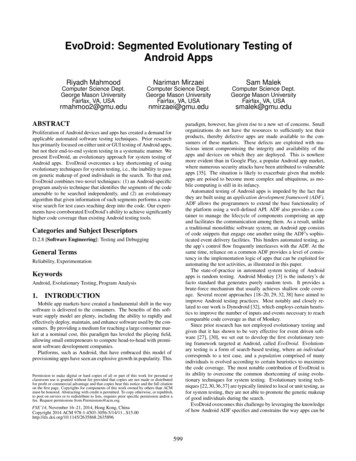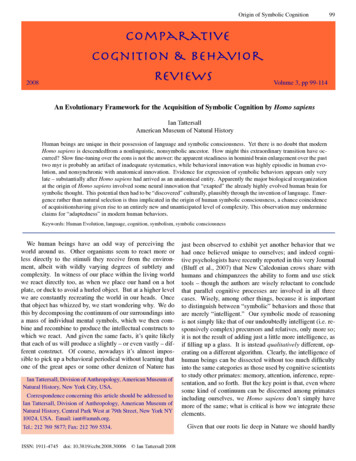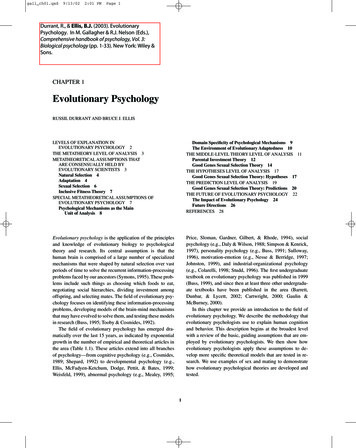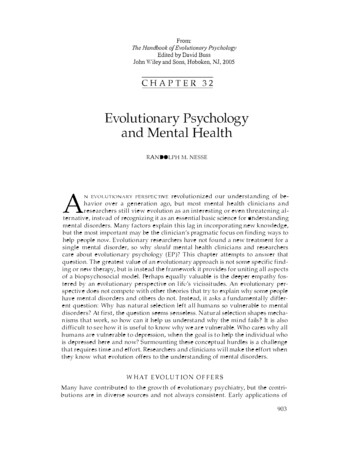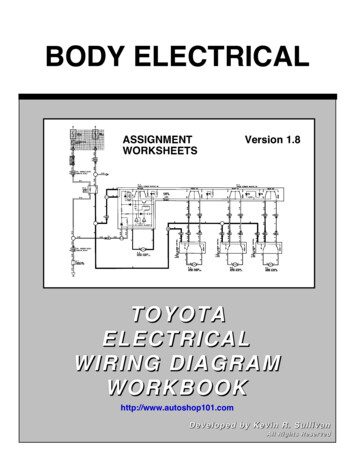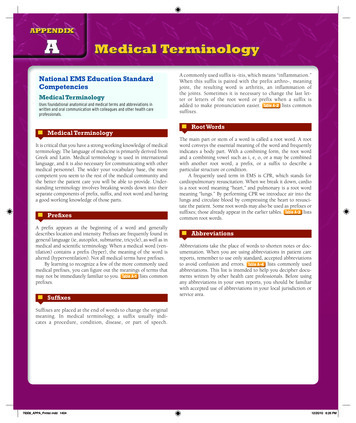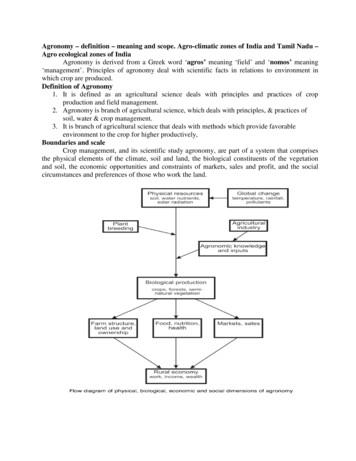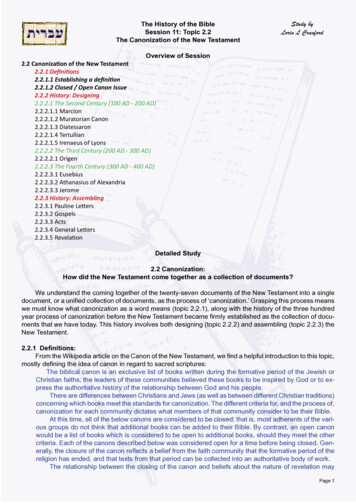
Transcription
Palaeobiogeographic and evolutionary meaning of anearly Late Tournaisian ammonoid fauna from the Tafilaltof MoroccoDIETER KORN, JÜRGEN BOCKWINKEL, VOLKER EBBIGHAUSEN, and CHRISTIAN KLUGKorn, D., Bockwinkel, J., Ebbighausen, V., and Klug, C. 2003. Palaeobiogeographic and evolutionary meaning of anearly Late Tournaisian ammonoid fauna from the Tafilalt of Morocco. Acta Palaeontologica Polonica 48 (1): 71–92.An early Late Tournaisian (Early Carboniferous/Mississippian) ammonoid fauna is described from the Tafilalt ofsouth eastern Morocco. Twelve genera, four of which are new, and eleven new species are represented: Becanitesafricanus sp. nov., Triimitoceras epiwocklumeriforme gen. et sp. nov., Irinoceras minutum sp. nov., Muensterocerasquadriconstrictum sp. nov., Eurites bouhamedensis sp. nov., Ouaoufilalites ouaoufilalensis gen. et sp. nov., Helicocyclusfuscus sp. nov., Pericyclus mercatorius sp. nov., Orthocyclus(?) sp., Bouhamedites enigmaticus gen. et sp. nov.,Winchelloceras antiatlanteum sp. nov., and Progoniatites maghribensis gen. et sp. nov. Palaeogeographic analysis ofLate Tournaisian ammonoid assemblages shows strong endemism at the species level, but genera and families had anearly global distribution in the equatorial seas. The new fauna contains the stratigraphically oldest known representa tives of the important Carboniferous goniatite families Girtyoceratidae and Goniatitidae.Key words: Ammonoide, palaeobiogeographya, Carboniferous, Tournaisian, Morocco.Dieter Korn [dieter.korn@museum.hu berlin.de], Naturhistorisches Forschungsinstitut, Museum für Naturkunde derHumboldt Universität zu Berlin, Invalidenstraße 43, D 10115 Berlin;Jürgen Bockwinkel [jbockwinkel@t online.de], Dechant Fein Straße 22, D 51375 Leverkusen;Volker Ebbighausen[volker@vxr.de], Engstenberger Höhe 12, D 51519 Odenthal;Christian Klug [christian.klug@uni tuebingen.de], Institut und Museum für Geologie und Paläontologie der Eberhard Karls Universität, Sigwartstraße 10, D 72076 Tübingen.IntroductionEarly Carboniferous ammonoids display an interesting patternin their palaeogeographic distribution. Before the Variscan(Hercynian) Orogeny, the genera and evolutionary lineageswere largely cosmopolitan, but during the orogenic phase, sig nificant provincialism emerged (Korn 1997; Korn et al. 1999).Little is known, however, about the driving force and the tim ing of the process. Such is the case with Tournaisian ammo noid faunas, which are less well known than those from theyounger Late Viséan and Serpukhovian. For biogeographicalanalyses, the investigation of diverse faunas is essential, andherein, the richest known early Late Tournaisian (i.e., Peri cyclus–Progoniatites genus zone) ammonoid fauna so far isdescribed from localities in the eastern Anti Atlas of Morocco.Monographic descriptions of the classical Late Tournai sian ammonoid faunas date back to the 19th century or thefirst half of the 20th century. The rich assemblages fromsouthern Ireland were described by Crick (1899) and Foord(1901, 1903), those from Belgium by de Koninck (1844,1880) and Delépine (1940), from the Rhenish Massif,Thuringia and the Harz Mountains of Germany by Holzapfel(1889) and Schindewolf (1926, 1939, 1951), from theActa Palaeontol. Pol. 48 (1): 71–92, 2003Montagne Noire of southern France by Böhm (1935), andthose from the Tafilalt of Morocco by Delépine (1941). Morerecently investigated were North American occurrences fromArkansas, Missouri, Indiana, and Michigan (e.g., Miller andCollinson 1951; Miller and Garner 1955; Gordon 1965), fau nas from the Holy Cross Mountains of Poland (Czarniecki1973; Dzik 1997), from the Tian Shan of Kirgizstan (Libro vitch 1927, 1940; Popov 1968), and from the South Urals,North Urals, and Pay Khoy of Russia (Kusina 1980, 2000;Popov and Kusina 1997).Most of these occurrences are latest Tournaisian in age(i.e., Ammonellipsites–Fascipericyclus genus zone). EarlyLate Tournaisian (Pericyclus–Progoniatites genus zone) as semblages are rare, and only the Rußschiefer of Thuringia,the Rockford Limestone of Indiana, as well as the Calcaire deVaulx and Calcaire de Calonne of Belgium represent thistimespan with rather diverse faunas. The fauna here de scribed from Ksar Bouhamed in the Tafilalt is the richest ofall and hence of special importance in the context of the EarlyCarboniferous ammonoids. With the description of this earlyLate Tournaisian assemblage, eleven new species are addedto the approximately twenty species already known from thisinterval.http://app.pan.pl/acta48/app48 071.pdf
72ACTA PALAEONTOLOGICA POLONICA 48 (1), 2003Late Tournaisian ammonoidoccurrences in AfricaTumulites – CravenocerasArnsbergites – Neoglyphioceras4 00’WGoniatites – MaxigoniatitesBeyrichoceras – EntogonitesBollandoceras – Bollandites31 30’NErfoudAAmmonellipsites – FascipericyclusFRissaniPericyclus – ProgoniatitesGoniocyclus – ProtocanitesLHamadaduGuirALOuedTaouzZizedOuKem4 30’W31 00’NTPareyn (1961) provided a list of 25 species from the “Séried’Hassi Sguilma”, mostly from the locality of Hassi Sguilmain the Saoura Valley of western Algeria. The fauna is com posed of species of Merocanites, Imitoceras, Irinoceras,Muensteroceras, Eurites, Dzhaprakoceras, Ammonellipsites,Fascipericyclus, Neopericyclus, and probably Winchello ceras. The fossils are not particularly well preserved, but theassemblage may be coeval to the Erdbach Limestone of theRhenish Massif, which is also latest Tournaisian (Ammonellip sites–Fascipericyclus genus zone) in age.Termier and Termier (1950) contributed the first recordsof Early Carboniferous ammonoids from southern Algeria.From Hassi Habadra in the Mouydir, northern central Sahara,ebbiErg ChZizedOuGattendorfia – EocanitesFig. 1. Ammonoid genus zones (right column) of the Early Carboniferous(Mississippian) with indication (bold characters) of the fauna described inthis publication. Serp., Serpukhovian.OuidaneChebbiITournaisian4 30’4 30’WsViseanLusitanoceras – LyrogoniatitesThe ammonoid material described here consists of more than1250 specimens, all collected from the surface at two locali ties near Taouz in the vicinity of Jebel Ouaoufilal, east ofKsar Bouhamed (Tafilalt, Morocco) (Fig. 2). All are from theOued Znaïgui Formation (Middle to Late Tournaisian), ThisRheriSerp.Eumorphoceras – CravenoceratoidesMaterialTEARLY CARBONIFEROUSAmmonoid faunas of Tournaisian age are known from sev eral places in North Africa (Delépine 1941; Termier andTermier 1950; Pareyn 1961), but the original descriptionswere never updated. The only recent investigation of Tour naisian ammonoids in the region is the work by Conrad(1984), who figured specimens from southern Algeria.The fossil lists from two horizons at the locality Bordjd’Erfoud, provided by Delépine (1941), consist of sixteenspecies, including one prolecanitid, three pericyclids, as wellas species belonging to Muensteroceras and Eurites. A LateTournaisian age is thus probable (Fig. 1). However the hori zons apparently were never collected again, although the lo cality is less than one kilometre from the town of Erfoud, oneof the centres of Moroccan fossil merchandising. Attempts tostudy the outcrop in recent years were not successful.they mentioned Pericyclus and Rotopericyclus. Most proba bly, this is also a Late Tournaisian occurrence. Tournaisianammonoids from various Central Saharan localities were fig ured by Conrad (1984). Among them were early Late Tour naisian assemblages with Becanites, Acrocanites, Imito ceras, Muensteroceras, Pericyclus, and Winchellocerasfrom Timimoun (south western Algeria) and from OuedTemertasset (Mouydir, southern Algeria). The latter is thefauna mentioned by Follot (1953) without description and il lustration. Conrad and Pareyn (1968) figured “Goniatites cf.crenistria” from Oued Temertasset. Of all the known Tour naisian ammonoid assemblages, these Central Saharan oc currences are the most similar to the assemblage from KsarBouhamed.25 kmKemCretaceous–QuaternaryOutcrop of Devonian rocksBouhamed localityFig. 2. Map of the Tafilalt (Eastern Anti Atlas, Morocco) with the KsarBouhamed locality (indicated by an asterisk) in the Tafilalt (EasternAnti Atlas, Morocco).
KORN ET AL.—TOURNAISIAN AMMONOID FAUNA FROM MOROCCOformation was first described by Hollard (1958) as “Courtesequence plus argileuse, formée de schistes à nodules alter nant avec des bancs gréseux” and later, in the local geologicalmap, named Formation Oued Znaïgui (Fetah et al. 1986). The500 metres thick unit is composed mostly of pelites. The ho rizon with the ammonoids is apparently limited to a fewmetres thickness. Only few other fossils such as gastropodsand rugose corals occur.The ammonoid fauna is remarkable for the small size ofthe specimens, none exceeding a phragmocone diameter of27 millimetres. All specimens are preserved as limoniticsteinkerns; body chambers and shell remains are only rarelypreserved.Twelve monospecific genera are represented. The num ber of specimens is as follows:Locality A (N 30º58.164' W 04º01.378'):Becanites africanus sp. nov.39 specimens (13.5%)Triimitoceras epiwocklumeriforme gen. et sp. nov. 16 specimens (5.6%)Irinoceras minutum sp. nov.5 specimens (1.7%)Muensteroceras quadriconstrictum sp. nov.185 specimens (64.2%)Eurites bouhamedensis sp. nov.3 specimens (1.0%)Ouaoufilalites ouaoufilalensis gen. et sp. nov.25 specimens (8.7%)Winchelloceras antiatlanteum sp. nov.4 specimens (1.4%)Progoniatites maghribensis gen. et sp. nov.11 specimens (3.8%)total288 specimensLocality B (500 metres west of locality A):Becanites africanus sp. nov.143 specimens (14.7%)Triimitoceras epiwocklumeriforme gen. et sp. nov. 43 specimens (4.4%)Irinoceras minutum sp. nov.12 specimens (1.2%)Muensteroceras quadriconstrictum sp. nov.602 specimens (61.8%)Eurites bouhamedensis sp. nov.9 specimens (0.9%)Ouaoufilalites ouaoufilalensis gen. et sp. nov.84 specimens (8.6%)Helicocyclus fuscus sp. nov.4 specimens (0.4%)Pericyclus mercatorius sp. nov.6 specimens (0.6%)Bouhamedites enigmaticus gen. et sp. nov.1 specimen (0.1%)Orthocyclus (?) sp.1 specimen (0.1%)Winchelloceras antiatlanteum sp. nov.48 specimens (4.9%)Progoniatites maghribensis gen. et sp. nov.21 specimens (2.2%)total974 specimensBoth assemblages are very similar in composition and pres ervation, and hence it is proposed that they represent the samefossil horizon. It is unclear whether they come from a singlefossiliferous bed or rather from a lithological unit of some ex tent. Time averaging of the fauna may thus be involved. The de scribed and illustrated specimens are housed in the collection ofthe Museum für Naturkunde der Humboldt Universität zu Berlin,abbreviated with the catalogue numbers MB.C. 3901 to 3988.Geological age of the faunaAccording to current knowledge, two successive complexesof late Tournaisian ammonoids can be distinguished; thePericyclus–Progoniatites and the Ammonellipsites–Fasci pericyclus genus zone (Fig. 1). The older is known from theCalcaire de Vaulx and Calcaire de Calonne of Belgium (deKoninck 1844, 1880; Delépine 1940), and is characterised by73the genera Protocanites, Imitoceras, Muensteroceras, andPericyclus. A fauna of the same age, but without Pericyclus,comes from the Rockford Limestone of Indiana (Hall 1860;Miller and Collinson 1951). The younger complex is knownfrom numerous localities, including the Erdbach limestoneof Germany (Rhenish Massif and Harz; Holzapfel 1889;Schindewolf 1951) and time equivalents from Ireland,France, Poland, North Russia, and Central Asia.Unfortunately, the newly described fauna cannot be pre cisely dated by other fossils of stratigraphic value; cono donts, for instance, have not been found. The ammonoid as semblage includes elements of Middle Tournaisian (e.g.,Becanites, Triimitoceras) and Late Tournaisian (e.g., Irino ceras, Pericyclus) aspect.The genus Becanites is the only representative of theprolecanitids, and so far is known mainly from Middle Tour naisian rocks. Advanced Late Tournaisian prolecanitids suchas Michiganites and Merocanites are absent. Prionoceratidsare represented by the simple lobed Triimitoceras, which hasaffinities to Late Devonian and Early Tournaisian forms suchas Mimimitoceras. As suggested by its suture line, nearestrelative of Triimitoceras is Imitoceras. Another priono ceratid in the fauna is Irinoceras, which is known from thelatest Tournaisian Erdbach Limestone and its time equiva lents as well as younger strata, ranging up into the Serpu khovian (Kullmann 1962; Ruzhencev and Bogoslovskaya1971). The muensteroceratids of the fauna, Muensterocerasand Eurites, show suture lines with very low median saddles(less than 20% of the external lobe depth), a characteristicfeature of the stratigraphically older species of these genera.Pericyclids are a minor component of the fauna, and thenew species Pericyclus mercatorius also possesses a verylow median saddle. It shows close similarities toPericyclus princeps, described from the early LateTournaisian Calcaire de Calonne of Belgium (de Koninck1880; Delépine 1940).It can thus be concluded that the Ksar Bouhamed fauna isearly Late Tournaisian in age (Fig. 1). This assignment issupported by the absence of advanced pericyclids such asAmmonellipsites and Fascipericyclus, which are typical forthe latest Tournaisian. Supplementary confirmation comesfrom the stratigraphical position of the similar fauna fromOued Temertasset (Mouydir, Central Sahara; Conrad 1984),which occurs there well below the limestone band withMerocanites and Ammonellipsites.Palaeobiogeography of LateTournaisian ammonoidsAll the rich Late Tournaisian ammonoid assemblages comefrom the tropical and subtropical seas, according to thepalaeogeographic maps of Scotese (1997). The localitieswere distributed between 35º latitude N and S. The Northhttp://app.pan.pl/acta48/app48 071.pdf
74ACTA PALAEONTOLOGICA POLONICA 48 (1), 200330 NTSPKNUSU0 MOARMIIRINTHSP30 SCMMNAASVoccurrences of latest Tournaisian ammonoidsHCRMBESAoccurrences of early Late Tournaisian ammonoidsFig. 3. Palaeogeographical map for the North Atlantic region of the Tournaisian age (after Scotese 1997; image by Ron Blakey, Flagstaff, Arizona), showingammonoid occurrences of late Tournaisian age. AR, Arkansas; MO, Missouri; IN, Indiana; MI, Michigan; SP, South Portugal; IR, Ireland; BE, Belgium;RM, Rhenish Massif and Harz Mountains; TH, Thuringia; HC, Holy Cross Mountains; SU, South Urals; NU, North Urals; PK, Pay Khoy; TS, Tian Shan;CM, Cantabrian Mountains; MN, Montagne Noire; AA, Anti Atlas; SV, Saoura Valley; SA, South Algeria.American faunas were separated from the others by land (theconnection between Laurussia and Gondwana) to the eastand ocean to the West. The European, North African, andAsian occurrences were located in shelf areas which wereprobably connected by shallow water seas (Fig. 3).The early Late Tournaisian ammonoid genera and speciesare distributed as follows:– Rußschiefer of Thuringia (Schindewolf 1926, 1939) – sixspecies,– Rockford Limestone of Indiana (Hall 1860; Miller andCollinson 1951) – five species,– Silovskaya Svita of the Pay Khoy in North Russia(Kusina 2000) – four species,– Calcaire de Vaulx and Calcaire de Calonne of Belgium(de Koninck 1844, 1880; Delépine 1940) – eight and ninespecies respectively,– Argiles de Teguentour of southern Algeria (Conrad 1984)– seven species.– Oued Znaïgui Formation of Ksar Bouhamed (describedherein) – twelve species.All the other known occurrences contain four or fewerspecies (Fig. 4). A quantitative analysis based on such a smalldata base is not possible. The palaeogeographical distribu tion of the main evolutionary lineages, represented in theKsar Bouhamed fauna, is as follows:Prolecanitids are distributed almost globally. Species ofBecanites occur in south western Portugal (Pruvost 1914),the Black Forest (Spiegelhalter 1910) and Upper Franconia(Schindewolf 1926) of Germany, the South Urals of Russia(Librovitch 1940), Chile (House 1996), as well as Missouriand Kentucky (Smith 1903). Prionoceratids are also widelydistributed and are represented by Irinoceras in the Late
GermanyRu ß schieferBelgiumCalcaire de VaulxBelgiumCalcaire de CalonneMoroccoOued Znaïgui Fm.AlgeriaTeguentour Fm.North UralsSilovskaya SvitaXingjiangDonggulobatisao Fm.USAMarshall SandstoneUSARockford Lst.New South WalesNamoi, Luton 11111111?1212211Fig. 4. Distribution of early Late Tournaisian ammonoid genera with thenumbers of species per genus in various regions.Tournaisian rocks of Belgium (de Koninck 1880; Delépine1940), Germany (Rhenish Massif, Harz Mountains;Holzapfel 1889, Schindewolf 1951), the Holy Cross Moun tains of Poland (Dzik 1997), Ireland (Foord 1901), southernFrance (Böhm 1935), Algeria (Pareyn 1961), Arkansas, Brit ish Columbia (Work, Nassichuk and Richards 2000), andNew South Wales in Australia (Campbell, Brown, andColeman 1983). Most of these faunas with Irinoceras aredominated by muensteroceratids, which in the KsarBouhamed assemblage comprise more than 60% of the spec imens. Such a high value is known from typical occurrencesof ammonoid faunas of early Late Tournaisian age. Also dis tinctive is Pericyclus and other pericyclids in the North Afri can, Central European, and North Russian (Kusina 2000) as semblages.Winchelloceras is a rare genus known from Michigan(Miller and Garner 1955), the North Urals (Kusina 1980), theTian Shan (Popov 1968), the Cantabrian Mountains (Higginsand Wagner Gentis 1982), Algeria (Conrad 1984), and Mo rocco. Progoniatites is known from Morocco, Algeria (Follot1953; Conrad and Pareyn 1968; Conrad 1984), Thuringia(Schindewolf 1926, 1939), and the Pay Khoy (Kusina 2000).This list demonstrates that almost all of the ammonoidgroups are distributed worldwide.Ammonoids from the latest Tournaisian are better knownthan those from the early Late Tournaisian (Fig. 5). Ten as semblages are included in a cluster analysis with the program75GermanyErdbach LimestoneBelgiumCalcaire WaulsortienPolandRadlin BedsIreland“Lower Limestone”SpainAlba FormationMoroccoNiveau d’ErfoudAlgeriaHassi Sguilma SeriesUSASt. Joe; Marshall Fm.KyrgistanDzhapryk FormationNorth UralsKosvinsky HorizonKORN ET AL.—TOURNAISIAN AMMONOID FAUNA FROM 1163211721111111111241111171111211211Fig. 5. Distribution of latest Tournaisian ammonoid genera with the num bers of species per genus in various regions.STATISTICA. This analysis is based on the distribution ofgenera. An analysis on the species level was not achieved be cause of the following reasons: (1) Many of the occurrenceshave endemic species which are not informative to discoverrelationships between the regions, and (2) the current knowl edge of some of the assemblages is too poor to allow exactconsiderations about the species composition. Therefore, thedistribution of species is only used as a supplementary fea ture.The 1 Pearson r algorithm was used to calculate a dis tance matrix for the analysed assemblages (Fig. 6A), and thecluster diagram (Fig. 6B) was done in the single linkagemode. As can be seen from both figures, four palaeobiogeo graphical units can be separated, three of them consistingonly of one region.The western Palaeotethyan unit embraces the Central andWestern European as well as the North African occurrences.Distance values within these are moderately high, approxi mately 0.70 on average, and all are assembled in one cluster.The occurrences of the American Midcontinent (Arkansas,Missouri) are regarded as one assemblage (USA); this is sep arated from the European/African samples by higher distancevalues of 0.85 on average. Even more distant from the west http://app.pan.pl/acta48/app48 071.pdf
.470.741.241.140.961.031.03Single Linkage1 Pearson AKirgizstanRussia0.400.450.500.550.600.650.70Fig. 6. Distance matrix and cluster diagram for the latest Tournaisianammonoid bearing regions.ern Palaeotethyan are the Tian Shan (Central Asia) and theNorth Urals.The geographic distribution of the main evolutionaryammonoid lineages confirms this pattern. Two of them(prolecanitids, muensteroceratids) are present in all the fourbiogeographical units. The prionoceratids were recorded inNorth America and Europe/Africa, and the pericyclids are di verse in North Africa, Europe, and Central Asia. Pericyclidsare only minor components of the North American and NorthRussian assemblages.Evolution of the familyGoniatitidaeThe presence of Progoniatites and Winchelloceras meansthat the Ksar Bouhamed assemblage contains the strati graphically oldest representatives of the families Gonia titidae and Girtyoceratidae. This is a remarkable fact sincethe Goniatitidae were thought to appear only in the LateViséan, with little being known about their ancestry. Themorphologically very similar Progoniatites and Goniatitesare separated by a rather large timespan (latest Tournaisian tomiddle Viséan), from which no representatives of the familyare known.EARLY CARBONIFEROUSLinkage distanceGoniatites naisian0.45This means that the Goniatitidae, one of the most com mon and geographically widespread families of the LateViséan (Korn 1988, 1997), is a Lazarus taxon that sud denly reappeared after a long period of time and then be came very diverse (Fig. 7). The cause of the gap in the re cord may be explained by the relatively poor state ofknowledge of the Early and Middle Viséan ammonoids,but also facies differences may play an important role.Late Tournaisian faunas are almost exclusively knownfrom well oxygenated limestone formations. However,too little is known about the ecology of Carboniferousammonoids to explain the pattern of distribution withindifferent facies belts. It is interesting that Progoniatites isnot an endemic genus, known from North Africa, CentralEurope, and the North Urals, and that Goniatites is alsodistributed almost globally.The presence of Progoniatites in early Late Tournaisianammonoid communities does not solve the riddle of the ori gin of the family Goniatitidae, as the ancestry of Goniatitesnow shifts to Progoniatites, of which no morphologicallysimilar form is known from time equivalents or stratigraphi cally older sedimentary landACTA PALAEONTOLOGICA POLONICA 48 (1), 2003Belgium76Progoniatites maghribensisFig. 7. Stratigraphical distribution of the Early Carboniferous genera of theGoniatitidae, displaying the gap in the record that spans from the latestTournaisian to the Middle Viséan.
KORN ET AL.—TOURNAISIAN AMMONOID FAUNA FROM MOROCCOSystematic palaeontology1.0Abbreviations used in the text are: ah, apertural height;dm, conch diameter; IZR, imprint zone width, calculated(wh ah)/wh; uw, umbilical width; WER, whorl expansionrate, calculated [dm/(dm ah)]2; ww, whorl width; wh, whorlheight (Fig. 8).whorl width(ww)0.80.6uw/dm0.4ww/dm0.0IZR 110100conch diameterFig. 9. Whorl width/ conch diameter and umbilical width/ conch diameterratios of Becanites africanus sp. nov.conch diameter (dm)whorl dm 2WER ( dm–ah )77(wh–ah)whFig. 8. The conch parameters and ratios as used in the descriptions.Family Prolecanitidae Hyatt, 1884Becanites Korn, 1997Type species: Protocanites algarbiensis Pruvost, 1914.pouched external lobe, lanceolate and pouched adventive andlateral lobe on the flank.Description.—All the specimens are similar in their conchgeometry and ratios, but juveniles are more evolute thanlarger specimens (Fig. 9). Juveniles have a circular whorlcross section, and adults display an oval, slightly compressedshape. The relative apertural height increases during ontog eny, resulting in an acceleration of the whorl expansion ratefrom 1.90 at 5 mm to 2.50 at 18 mm conch diameter. In thisrespect, B. africanus has an ontogeny that is typical for theprolecanitids.The surface of the steinkern is smooth without any indica tion of ornament. It can therefore be assumed that the shell isvery weakly ornamented.The suture line is characteristic for Becanites (Fig. 10),but the external lobe, as seen in paratype MB.C.3909, is ex tremely large and bulb shaped, as known only from strati graphically younger and more derived genera such as Michi ganites Ruzhencev, 1962 and Prolecanites Mojsisovics,1882. The adventive lobe and the lateral lobe, which are bothlocated on the flank, are also pouched and pointed at the bot tom.Dimensions.—(in mm).Becanites africanus sp. nov.Figs. 9, 10, 11A–C.Derivation of name: After the continent from where the specimens werecollected.Holotype: Specimen MB.C.3901 (coll. Bockwinkel), Fig. 11A.Type locality and horizon: Taouz, Jebel Ouaoufilal, locality A east ofKsar Bouhamed (Tafilalt, Morocco); early Late Tournaisian.Material.—182 mostly fragmentary specimens, 5 to 20 mmin diameter.Diagnosis.—Becanites with discoidal conch (ww/dm 0.35).Umbilicus wide at 8 mm diameter (uw/dm 0.45 to 0,50) andmoderately wide at 15 mm diameter (uw/dm 0.40). Flanksand venter broadly rounded. Suture line with large and /dmww/whuw/dmIZR17.49 .502.772.532.381.85Comparisons.—B. africanus sp. nov. is, by its large andstrongly pouched external lobe, different from the otherspecies of the genus: B. algarbiensis (Pruvost, 1914), B.abnobensis (Vöhringer, 1960), B. geigenensis (Schmidt,http://app.pan.pl/acta48/app48 071.pdf
78ACTA PALAEONTOLOGICA POLONICA 48 (1), 2003Family Prionoceratidae Hyatt, 1884Subfamily Imitoceratinae Ruzhencev, 1950Triimitoceras gen. nov.Derivation of name: After the triangularly coiled inner whorls, and thesimilarity with Imitoceras.Type species: Triimitoceras epiwocklumeriforme sp. nov.2 mmAB1 mmFig. 10. Suture lines of Becanites africanus sp. nov. A. MB.C.3909 at ww6.9 mm, wh 7.9 mm; 5. B. MB.C.3905 at dm 4.8 mm, ww 1.8 mm, wh1.55 mm; 20.1925), B. gurleyi (Smith, 1903), B. sernageominus (House,1996), and B. nuraensis (Librovitch, 1940). Furthermore,B. algarbiensis, B. sernageominus and B. geigenensis aremore widely umbilicate (uw/dm 0.50) than B. africanus sp.nov.Diagnosis.—Imitoceratidae with discoidal conch that is tri angularly coiled in juveniles. Aperture and whorl expansionrate low (WER 1.50 to 1.70). Suture line with slightlypouched external lobe and large, V shaped adventive lobe.Comparisons.—Triimitoceras has a suture line typical for thefamily Imitoceratinae. As in Imitoceras Schindewolf, 1923,the external lobe is slightly pouched, the ventrolateral saddle isstrikingly asymmetrical, and the adventive lobe is muchdeeper than the external lobe. However, the conch of Triimito ceras is thinner with lower aperture, and the conspicuoussteinkern constrictions of the type species (see below) are notknown from Imitoceras. The cardinal difference, of course, isthe triangular coiling of the inner whorls of Triimitoceras, notknown from any other Carboniferous prionoceratid.Occurrence.—Only known so far from the vicinity of JebelOuaoufilal; Oued Znaïgui Formation, early Late Tournaisian.C2C1B1A1D1A2F1E1B2E2G1D2F2G2H1H2Fig. 11. A. Becanites africanus sp. nov., holotype MB.C.3901. B. Becanites africanus sp. nov., MB.C.3904. C. Becanites africanus sp. nov., MB.C.3906.D. Triimitoceras epiwocklumeriforme sp. nov., MB.C.3988. E. Triimitoceras epiwocklumeriforme sp. nov., holotype MB.C.3910. F. Triimitocerasepiwocklumeriforme sp. nov., MB.C.3914. G. Irinoceras minutum sp. nov. MB.C.3921. H. Irinoceras minutum sp. nov. holotype MB.C.3916. All 3. Allspecimens figured in apertural (A1, B1, etc.; except for D1 in ventral) and lateral (A2, B2, etc.) views.
KORN ET AL.—TOURNAISIAN AMMONOID FAUNA FROM MOROCCO1.00.8ww/dm0.60.40.20.0uw/dm110100conch diameterFig. 12. Whorl width/conch diameter and umbilical width/conch diameterratios of Triimitoceras epiwocklumeriforme sp. nov.79Three strong constrictions per volution are visible in allspecimens (steinkerns). In small individuals (dm 6 mm),such as the paratype MB.C.3915, they form a weak ventro lateral projection, but larger specimens (dm 13 mm), such asthe holotype MB.C.3910 display a prominent tongue shapedextension of the ventrolateral salient and a deep ventral sinus.The conch interior between the constrictions is smooth.The suture of the holotype MB.C.3910 resembles, in thegeneral outline, that of Imitoceras: the external lobe isslightly pouched, it is not as deep as the large adventive lobe,and the ventrolat
Palaeobiogeographic and evolutionary meaning of an early Late Tournaisian ammonoid fauna from the Tafilalt of Morocco DIETE

